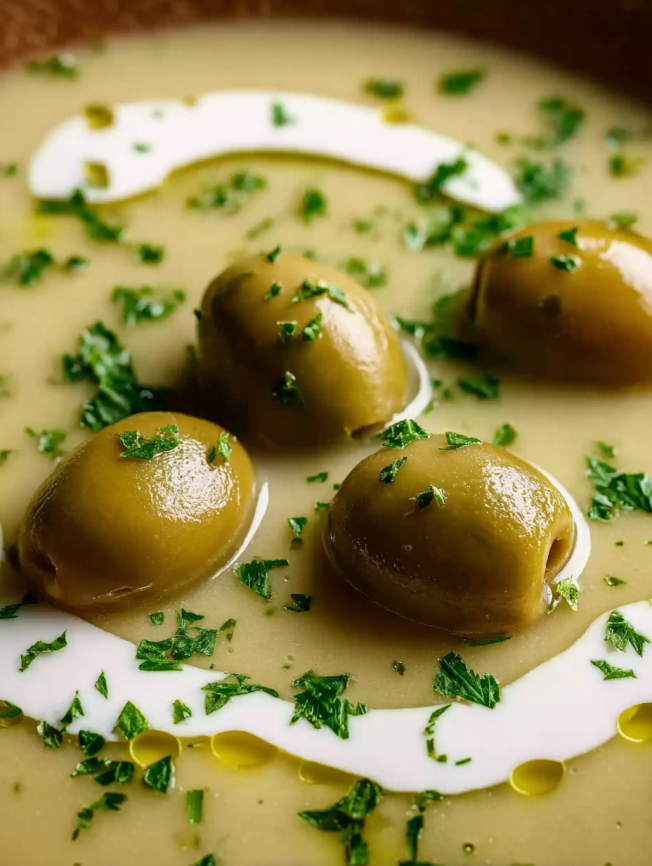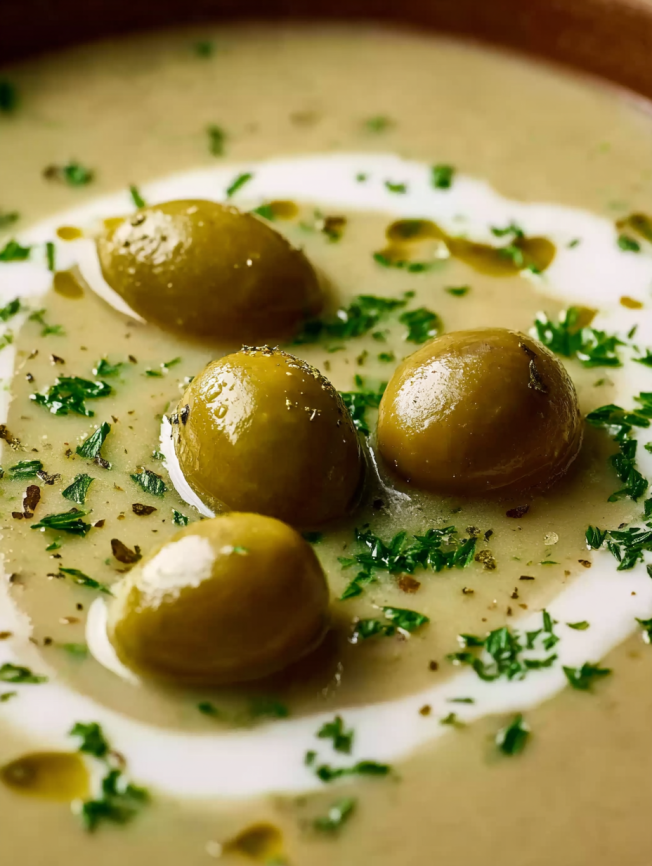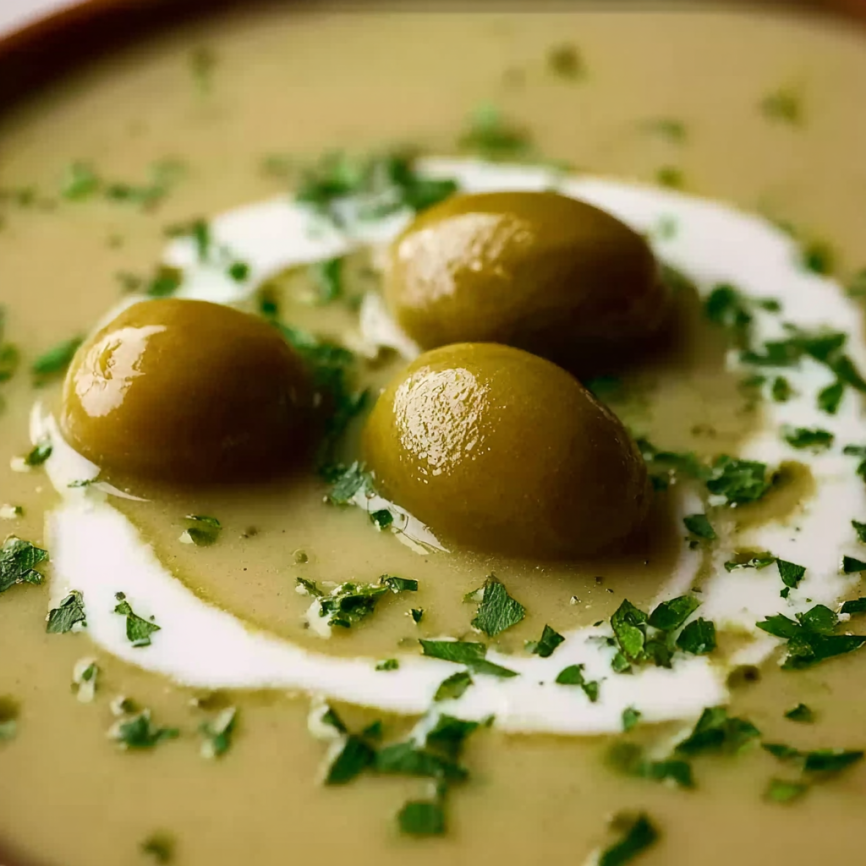Total Time: 30 minutes
There’s something magical about discovering a recipe that completely defies expectations. While browsing through my grandmother’s handwritten recipe collection last winter, I stumbled upon a faded note that simply read “olive soup – trust me on this one.” Initially skeptical, I decided to give it a try during a particularly dreary February evening. What emerged from my kitchen was nothing short of revelatory – a creamy, briny, utterly satisfying soup that has since become one of my most requested recipes.
Green Olive Soup challenges everything you think you know about comfort food. This unexpected culinary gem transforms humble green olives into a sophisticated, umami-rich broth that feels both familiar and exotic. Furthermore, it bridges the gap between simple weeknight cooking and restaurant-worthy presentation, making it perfect for both casual dinners and dinner party starters.
Why You’ll Fall in Love with This Green Olive Soup
Unexpected Flavor Profile
Most people don’t expect olives to be the star of a soup, but that’s precisely what makes this recipe so special. The briny, savory notes create a complex flavor base that’s both comforting and sophisticated. Additionally, the Mediterranean herbs and creamy finish balance the saltiness beautifully, creating a harmonious bowl that keeps you coming back for more.
Quick and Simple Preparation
Despite its gourmet taste, this soup comes together in just 30 minutes using pantry staples and fresh ingredients you likely already have. Moreover, the one-pot cooking method means minimal cleanup – always a win on busy weeknights. The straightforward technique makes it accessible for novice cooks while still delivering restaurant-quality results.
Versatile and Customizable
This base recipe serves as a fantastic foundation for creativity. Whether you prefer it completely smooth or with rustic texture, vegan or dairy-rich, this soup adapts to your preferences effortlessly. Furthermore, it pairs beautifully with various garnishes and sides, making it suitable for different occasions and dietary needs.
Essential Ingredients for Green Olive Soup
Main Components
- 1 tbsp olive oil – Creates the aromatic base
- 1 small onion, finely chopped – Adds sweetness and depth
- 2 cloves garlic, minced – Provides essential Mediterranean flavor
- 1 stalk celery, finely chopped – Contributes subtle earthiness
- ¼ tsp crushed red pepper flakes (optional) – Adds gentle heat
- 3 cups vegetable broth – Forms the soup’s foundation
- ½ cup green olives, pitted and sliced – The star ingredient (Spanish or Castelvetrano work best)
- 1 medium potato, peeled and diced – Creates natural creaminess
- 1 tsp dried oregano – Essential Mediterranean herb
- ½ tsp smoked paprika (optional) – Adds depth and color
Creamy Base Elements
- ½ cup plain Greek yogurt or sour cream – Creates luxurious texture
- 1 tbsp fresh lemon juice – Brightens the entire dish
- 1 tsp lemon zest – Intensifies citrus notes
- Optional: 2 tbsp cream cheese or splash of oat milk – For extra richness
Garnish Options
- Fresh parsley or dill, chopped
- Extra sliced olives
- Cracked black pepper
- Homemade croutons or crusty bread
Step-by-Step Cooking Instructions
Building the Flavor Base
Step 1: Create the Aromatic Foundation Begin by heating olive oil in a heavy-bottomed soup pot over medium heat. Once the oil shimmers, add the finely chopped onion and celery. Sauté these vegetables for 4-5 minutes, stirring occasionally, until they become soft and translucent. Next, add the minced garlic and cook for an additional 30 seconds until fragrant. If you’re using red pepper flakes, stir them in now to release their heat into the oil.
Developing the Soup Base
Step 2: Build the Soup Foundation Add the diced potato, sliced green olives, vegetable broth, dried oregano, and smoked paprika to the pot. The combination of ingredients should create an aromatic mixture that already hints at the delicious soup to come. Bring this mixture to a rolling boil, then reduce the heat to maintain a gentle simmer.
Step 3: Simmer to Perfection Allow the soup to cook uncovered for 15-20 minutes, or until the potatoes are completely tender when pierced with a fork. During this time, the flavors will meld together, and the potatoes will begin to break down slightly, naturally thickening the broth.
Creating the Perfect Texture
Step 4: Achieve Desired Consistency Using an immersion blender, carefully blend the soup to your preferred consistency. For a rustic texture, pulse briefly to break up larger pieces while leaving some chunks intact. Alternatively, blend until completely smooth for a more refined presentation. If you don’t have an immersion blender, transfer half the soup to a regular blender, blend until smooth, then return it to the pot.
Step 5: Add the Creamy Finish Remove the soup from heat and gradually stir in the Greek yogurt, fresh lemon juice, and lemon zest. Mix thoroughly until the soup becomes creamy and well-integrated. Taste and adjust seasoning with salt and black pepper as needed, keeping in mind that the olives already contribute significant saltiness.
Final Presentation
Step 6: Serve with Style Ladle the hot soup into warmed bowls and garnish generously with chopped fresh herbs, additional sliced olives, and a generous grind of black pepper. Serve immediately alongside crusty sourdough bread, warm pita chips, or homemade croutons for a complete meal experience.
Serving Suggestions and Pairings
Perfect Accompaniments
This soup shines when paired with Mediterranean-inspired sides. Crusty sourdough bread provides the perfect vehicle for savoring every last drop, while warm pita bread offers a more traditional Mediterranean touch. Additionally, a simple arugula salad dressed with lemon vinaigrette complements the soup’s rich flavors beautifully.
Wine Pairings
The briny, savory notes of this soup pair wonderfully with crisp white wines such as Sauvignon Blanc or Pinot Grigio. Alternatively, a light-bodied red wine like Pinot Noir can complement the earthy undertones without overwhelming the delicate olive flavors.
Portion Considerations
As a starter, this recipe serves 4-6 people generously. However, when served as a main course with bread and salad, it comfortably feeds 3-4 adults. The rich, satisfying nature of the soup means smaller portions are surprisingly filling.

Creative Recipe Variations
Protein-Packed Version
Transform this soup into a more substantial meal by adding cannellini beans or chickpeas during the simmering stage. These legumes not only increase the protein content but also complement the Mediterranean flavor profile perfectly. Simply drain and rinse one can of beans before adding them with the broth.
Vegan Adaptation
Make this soup completely plant-based by substituting the Greek yogurt with cashew cream or high-quality dairy-free yogurt. Coconut cream also works beautifully, though it will add a subtle tropical note that some find appealing. Additionally, ensure your vegetable broth is certified vegan.
Herb-Forward Variation
For herb lovers, try adding fresh thyme and rosemary during the simmering stage, then finish with a generous amount of fresh basil or mint. This creates a more complex herbal profile that’s particularly delicious during spring and summer months.
Spicy Mediterranean Twist
Increase the red pepper flakes and add a pinch of cayenne pepper for those who enjoy more heat. You might also consider adding a few sun-dried tomatoes for additional depth and slight sweetness that balances the spice beautifully.
Make-Ahead Tips and Storage
Preparation Strategies
This soup actually improves in flavor when made ahead, as the ingredients have more time to meld together. Prepare the soup completely through the blending stage, then refrigerate for up to 3 days. When ready to serve, gently reheat while stirring in the yogurt and lemon components fresh for the best texture and flavor.
Freezing Instructions
The soup base freezes beautifully for up to 3 months when stored in airtight containers. However, avoid adding the yogurt and lemon before freezing, as dairy can separate when thawed. Instead, add these finishing touches after reheating the thawed soup base.
Reheating Guidelines
When reheating leftover soup, do so gently over low heat to prevent the yogurt from curdling. Stir frequently and avoid bringing the soup to a rolling boil. If the soup seems too thick after storage, thin it with a little additional broth or water until you reach the desired consistency.
Professional Notes and Tips
Olive Selection Matters
The quality and type of olives significantly impact the final flavor of your soup. Spanish Manzanilla olives provide a classic, well-balanced flavor, while Castelvetrano olives offer a milder, buttery taste that’s particularly appealing to those new to olive-forward dishes. Avoid using very salty or heavily seasoned olives, as they can overpower the other flavors.
Balancing the Brine
Since olives are naturally salty, always taste your soup before adding additional salt. The lemon juice and yogurt help balance the brininess, but you may find that no additional salt is needed at all. Start conservatively with seasonings and adjust gradually.
Texture Preferences
The beauty of this soup lies in its adaptability to different texture preferences. Some prefer it completely smooth and elegant, while others enjoy a more rustic, chunky consistency. Experiment with different blending times to find your perfect texture.
Fresh vs. Dried Herbs
While this recipe calls for dried oregano for convenience, fresh herbs can elevate the dish significantly. If using fresh oregano, add it during the last few minutes of cooking to preserve its bright flavor. Fresh thyme, basil, or even mint can provide interesting flavor variations.

Frequently Asked Questions
Can I use different types of olives in this soup? Absolutely! While green olives are traditional, you can experiment with Kalamata olives for a more intense flavor or even use a mixture of different olive varieties. Keep in mind that darker olives will change the soup’s color and tend to have a stronger, more complex flavor profile.
What if I don’t have an immersion blender? No problem! You can use a regular blender, but work in batches and be careful with the hot liquid. Alternatively, use a potato masher to break up the ingredients partially, which will give you a chunkier but still satisfying texture. Some people actually prefer this rustic approach.
How can I make this soup less salty? If your finished soup tastes too salty, there are several solutions. First, add more lemon juice, which helps balance saltiness. You can also stir in additional yogurt or even add a peeled, diced potato and simmer for 10 more minutes to absorb excess salt. Finally, diluting with a bit more low-sodium broth can help.
Is this soup suitable for meal prep? Yes, this soup is excellent for meal prep! The flavors actually develop and improve over time. Store portioned servings in the refrigerator for up to 4 days or freeze individual portions for up to 3 months. Just remember to add fresh lemon juice and a dollop of yogurt when reheating to refresh the flavors.
Can I make this soup in a slow cooker? While possible, the quick cooking time doesn’t really benefit from slow cooking. However, if you prefer this method, sauté the vegetables first, then transfer everything to your slow cooker and cook on low for 3-4 hours. Add the yogurt and lemon components during the last 30 minutes of cooking.
What’s the best way to serve this for a dinner party? For elegant presentation, serve the soup in warmed bowls with a drizzle of good olive oil, a few whole olives as garnish, and fresh herb sprigs. Provide warm, crusty bread on the side and consider offering a small dish of additional lemon wedges for guests who want extra brightness.
Prep Time: 10 minutes
Cook Time: 20 minutes
Cuisine: Mediterranean-Inspired – Creative Soups

